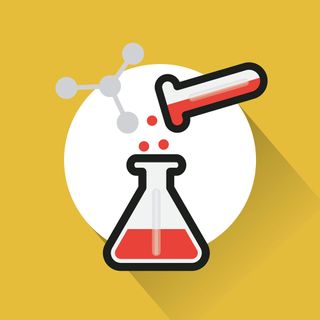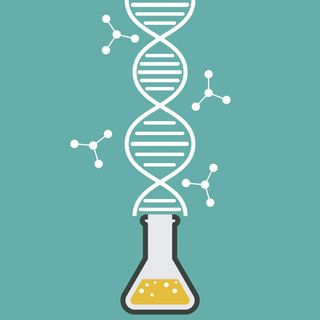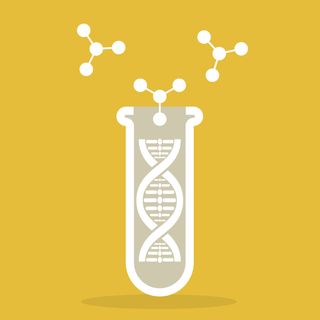Can DNA Testing Unlock Your Fitness Potential?
A range of easy and affordable genetic tests promise personalised insights into your body. Can these tests really crack the fitness code?

Twirl the cotton swab around your cheek, seal your DNA sample in the plastic tube provided, post it off to the laboratory, and await a personalised report on your deepest genetic secrets.
Thanks to consumer DNA testing kits, you can now pay to discover your genetic sensitivity to saturated fat and gift for muscle growth (DNAFit.com, £149), your ancestral ethnicity (Ancestry.co.uk, £79) or even the tastiest wines for your unique palate (Vinome.com, £46). With a single sample you can learn about your genetic risk of lung disease and Alzheimer’s while uncovering unexpected traits, from your susceptibility to mosquito bites to your earwax type (23andMe.com, £149).
Whether life-changing or playfully intriguing, personal genetic testing is big business. Over 12 million people have used these consumer DNA tests, and the market was valued at $359 million (around £284 million) in 2017 and is expected to hit $928.8 million (£734 million) by 2023. DNAFit was ranked in the Top 10 most innovative companies in data science by Fast Company magazine in 2017, while personal genome company 23andMe has been valued at $1.8 billion.
This genetic revolution has been brewing since 14th April 2003, when scientists confirmed the completion of the Human Genome Project – a 13-year, $2.7 billion quest to sequence the three billion chemical base pairs, consisting of adenine (A), thymine (T), guanine (G) and cytosine (C), that make up the human genome. A genome is a complete set of deoxyribonucleic acid (DNA) which contains all the genetic instructions needed to build and maintain a living organism. The research promised a new age of personalised healthcare with more accurate diagnosis of diseases and bespoke health interventions.
While today’s academics and health professionals focus their genetic research on momentous issues like rare diseases and cancer, commercial testing companies have opened up the science to inquisitive consumers. All humans are 99.9% identical but it is in that 0.1% genome variation that the answers to many health mysteries lie. That’s why most consumer DNA tests scan for particular genetic variants known as single nucleotide polymorphisms (or SNPs, pronounced “snips”) which genetic research has linked to everything from an elevated risk of Parkinson’s disease to higher power-training potential or quicker post-exercise recovery.
When DNAFit launched in 2013 it initially worked with Premier League footballers and Olympic athletes, who welcomed the chance for such bespoke insights. “The headline in the elite sport context was injury predisposition,” explains Andrew Steele, Beijing 2008 4x400m bronze medallist and head of product at DNAFit. “We looked at things like genetic risk of achilles injuries to see who might need preventative work.” The tests also informed training protocols: a study in Biology Of Sport suggested that athletes who trained for eight weeks in a manner that matched their genes (whether they respond better to low-intensity or high-intensity training) increased their jump test results by 7.4%, compared with 2.6% in the mismatched group. When the London 2012 long jump champion Greg Rutherford discovered through DNAFit that he had an endurance-based DNA, he changed his training to include more hill runs and more reps in the gym. “Elite sports use a lot of information, from GPS to blood markers, and we just add another metric,” says Steele.
The tests also boosted nutritional awareness. Many footballers were tested for their variant of the LCT gene, which creates lactase, the enzyme that digests the lactose sugar in milk. Those with the CC variant are often lactose-intolerant. “Players who are not of central northern European descent are genetically very unlikely to be lactose-tolerant, but they were having lactose-heavy recovery shakes,” says Steele. “Those players soon changed to personalised recovery shakes.”
Get the Coach Newsletter
Sign up for workout ideas, training advice, reviews of the latest gear and more.

DNAFit’s consumer tests, which scan for 45 gene variants, have now been used by tens of thousands of non-pro athletes. “When we launched we thought it would be for high-achieving athletes,” says Steele. “But those with the most to learn were everyday achievers with a health goal who just want to work out or eat better.”
Customers receive a genetic report with suggested interventions. For example, if you have the GG variant of the peroxisome proliferator-activated receptor alpha (PPARA) gene, which regulates energy metabolism, you are likely to respond better to endurance-based exercise, whereas anyone with the CC variant tends to respond better to power training. “If someone wants to put on muscle, some trainers might say they need to do heavy five-rep maxes while another might suggest doing lighter sets to failure,” explains Steele. “We are saying: from what we know about your genes, what is the best point on that spectrum for you? Someone with a higher endurance response might prioritise lighter reps but more overall volume.”
The tests can inform everything from nutrition to recovery protocols. If you have the AA variant of the tumor necrosis factor (TNF) gene, you may suffer more post-exercise inflammation and therefore benefit from more omega 3s. And if you have the AA variant of the fat mass and obesity-associated protein FTO, which is linked to an increased sensitivity to fats, you might need to eat less fat than other people.
See related
The theory is compelling, but how robust is the scientific basis for this kind of bespoke personal analysis? “I don’t think there is anything available now that has any utility whatsoever,” says Professor Bill Newman, who specialises in translational genomic medicine at the University of Manchester. “I don’t have many concerns about people wanting to buy tests and find out some information. But what it tells them isn’t very useful. I wouldn’t do it. I spend my life working in genetics and working with patients with inherited conditions and genetic information is incredibly valuable when used in the right way. But nearly all these are just vanity tests.”
Newman is also concerned about the advice accompanying the results. “There aren’t the studies that say, ‘if you have this particular variant and you do this it will be better’. Those studies just haven’t been undertaken.”
Dr Kat Arney, author of How To Code A Human, is equally sceptical. “Consumer tests are good because they encourage people to be interested in their genome, but the data these tests are based on comes from very large population studies and makes personal correlations we really don’t have the data for.” The small number of variants tested for also concerns her. “Your genome is 20 million genes and there are one million control switches turning those genes on and off and responding to your environment, so to look at a handful is laughable.”
Steele says that, in terms of identifying a person’s gene variants you have, DNAFit’s tests are “extremely accurate” and its experts examine hundreds of studies to establish the validity of their recommendations. “We only report on genetic variants that have good scientific consensus, with multiple, published peer-reviewed studies showing that gene links to that trait. We don’t give information for information’s sake – only if it is actionable or modifiable through exercise, nutritional or lifestyle changes.” External research shows promise: an Italian study of 191 obese people found that those who followed a diet modified to their personal genetics lost 33% more weight than those merely counting calories.

Still, most testing companies acknowledge their limits. The DNAFit website says, “Recommended fitness or nutrition regimes must not be built solely on genetic results. Environmental factors play a more important role than genetics.” The health component of 23andMe’s services was banned by the US regulator in 2013 due to insufficient supporting evidence, but it was reinstated in 2017 with permission to test for fewer conditions.
However, the US National Library of Medicine says that while tests cannot tell you anything definitive about disease and may cause people to make decisions based on incomplete information, they can promote awareness. Matt Jolley, a personal trainer at Evergreen Life, which offers DNA analysis, believes genetic tests encourage positive change. “This knowledge increases your confidence and persistence,” he says. “One marker relates to myostatin inhibition, which limits muscle growth – and I have it myself. It made me accept that I can’t ‘ego lift’ anymore. I am unlikely to grow quickly so I focus on three-second negatives and on my muscle contractions to squeeze blood into the muscle instead. It motivated me to accept a stricter programme.”
Jolley says ten of his clients have benefited from genetic testing. “It’s a big time-saver. In my experience I manage to save 12 weeks of training with a client as you find out what they are genetically likely to excel at.” One client discovered they were likely to have a lesser fat loss rate from strength and endurance training, but should respond well to power training. So Jolley got them doing power-based intervals, body combat classes, and one- to three-rep maxes of squats and deadlifts to burn fat by increasing their metabolic rate instead. “They saw faster fat loss and a higher retention of muscle,” he says.
Newman accepts genetic tests can be powerful motivators. “Absolutely – but it’s the placebo effect. If you are told this important scientific data suggests you do squat thrusts and a 5km run, you do it. But you could have been told something different and you would have complied with that too.” There is also the danger of negative reactions: if you discover you have a low sensitivity to fat, might you be tempted to over-indulge? “In truth, it is not going to cause huge amounts of harm,” says Newman. “But if I saw a genetic test for sale in a pharmacy I would buy some nice bubble bath instead.”

Perhaps it is inevitable that such tests are popular in today’s age of personalised, on-demand preferences. “Everyone loves the idea of something personalised to them and there is nothing more personal than your genome,” says Arney. “But your genome is not your destiny. There is nature and nurture.” She is especially troubled by how customers might react to ‘bad’ news: “I would be very wary of anyone saying, ‘I love football, but I don’t have the right muscle to play’.”
Steele says this should never be an issue. “People think they will be told what they can or can’t do. With no other data point in science do people think that. There is no scientific or ethical basis that a genetic result can be a form of Talent ID. We don’t use it to change your goal. We just use it to change how you try to get to that goal. This is not a magic pill. But we give customers knowledge and the empowerment to understand.”
All experts agree that genetic testing will play a big role in future, from cancer diagnoses to our understanding of weight gain. “There are some large initiatives, such as the UK Biobank, which are undertaking large population-based genetic studies,” says Newman. “From those we will be able to draw better conclusions about the relationship between genetic variants and traits such as weight and response to exercise.”
And DNA testing companies may have a key role to play. Around 85% of 23andMe’s five million customers agree to allow their anonymised results to be used for wider research with partners such as pharmaceutical companies Pfizer and GlaxoSmithKline. So while seeking personal insights, customers could also aid major human health discoveries. “As these companies mature and get more data they will be more informative,” says Newman. “The issue is whether you want this to happen in a commercial setting or to have healthcare organisations and research groups take it forward.”
Looking to the future, Steele is most excited about how artificial intelligence and machine learning may help DNAFit to better identify the genetic commonalities of people who achieve the same fitness goal. “We are forming a large data set so we can hopefully say, ‘the top 10% of people with this genotype reached their goal quickest in this particular way’ and then feed that insight back into the product. That will be really exciting. We know we are only at the tip of the iceberg when it comes to research – but the iceberg is there.”
Mark Bailey is a features writer and interviewer who contributed to Coach magazine in 2015 and Men’s Fitness UK, which predated, and then shared a website with, Coach, until 2019. Mark has also written for national newspapers including The Telegraph and The Financial Times Magazine, as well as magazines and websites such as Cyclist and Bike Radar.
